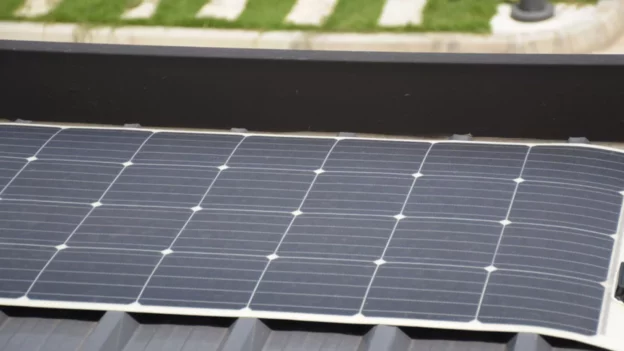Japan has formed a consortium of 150 public and private entities to accelerate the adoption of flexible perovskite solar panels. This Japanese technology aims to outperform the Chinese PV industry with more efficient, versatile and durable modules.
Flexible solar panels: Japan’s bet
Although Japan lost its lead in silicon production to China, the country is determined to avoid making the same mistakes in the perovskite business . To this end, it has invested more than US$400 million in the production of photovoltaic cells based on this innovative technology and has created a consortium of 150 companies and public and private organizations to drive the introduction of next-generation flexible solar panels.
As for the first steps, the consortium will set a target for perovskite cell capacity by 2040 this summer, according to Nikkei. Current projections point to 38.8 GW, with the possibility of exceeding the capacity of conventional solar panels (70 GW) in the next decade, reaching 84.2 GW in 2050.
Although these projections may vary, the target will be included in the government’s renewable energy strategic plan, which will need to be updated, as the 2021 version does not include capacity targets for perovskite solar panels.
More efficient solar cells
These photovoltaic cells, invented by Japanese scientist Tsutomu Miyasaka, have a crystalline structure similar to that of the eponymous rare mineral. They are more efficient at converting sunlight into electricity and can be cheaper to produce. In addition, its degradation is slower over time.
Being thinner and more flexible than silicon cells, these new cells offer a variety of installation possibilities, from balconies and canopies to vehicles and other locations where rigid solar panels are unfeasible or impractical.
In the fight against China, which dominates more than 80% of the solar industry supply chain and a major share of polysilicon production, Japan has decided to bet big. Perovskite has advanced to surpass the efficiency of conventional silicon cells, and Japan has seen a clear opportunity to compete in the market.
Currently, there are two types of perovskite solar panels: film and glass. Japan is betting on flexible film, although much research remains to be done to achieve the efficiency of conventional panels without using toxic metals such as lead.
Japanese solar consortium with Toshiba and Sekisui
The consortium is led by Toshiba and Sekisui Chemical which are already developing cells of this new material and plan to commercialize it next year. Other prominent members include Panasonic, automotive component supplier Aisin, chemical manufacturer Kaneka and Japan Railways Group. Among the public entities involved are Japan’s Ministry of Economy, Trade and Industry and numerous local governments, including the Tokyo Metropolitan Government.
The implementation of perovskite solar panels could also revolutionize the sustainable mobility industry. Electric and autonomous vehicles could benefit from this technology by integrating solar cells on their surfaces to extend their autonomy and reduce dependence on the power grid.
Follow us on social networks and don’t miss any of our publications!
Inspenet.com YouTube LinkedIn Facebook Instagram X
Source: xataka
Photo: Shutterstock

